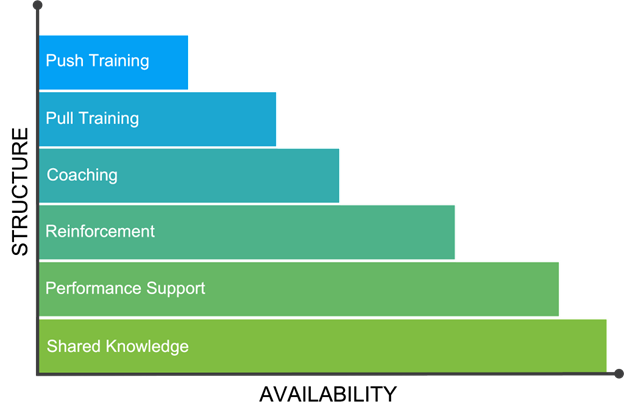ATD Blog
The Problem With Learning in the Flow of Work
Wed Nov 23 2022

Bookmark
Have you heard the phrase “learning in the flow of work”?
Chances are you have—probably a few times. Few contemporary L&D concepts are referenced more often than LITFOW. Yes, I made up the abbreviation, so I don’t have to type the entire phrase over and over again. No, you shouldn’t use it in conversation.
Thankfully, this is more than just another buzzword. While LITFOW is far from new, it represents an important transition in L&D strategy. Traditional workplace learning tactics, such as classroom sessions and online courses, are inherently disruptive. They require employees to step away from their work for lengthy periods of time. When an operation is short-staffed or dealing with tight deadlines, it’s nearly impossible to pull people away. After all, people don’t go to work to learn; they’re there to do a job. Therefore, to provide greater value, enable continuous skill building, and reduce disruption, L&D teams are adopting LITFOW and providing resources when and where people need them on the job.
Instead of making employees come to us, we’re finally bringing learning and development to them!
LITFOW is common sense. It acknowledges that people do most of their learning on the job (à la the 70-20-10 model). LITFOW-based activities help people focus on the right skills, solve problems more effectively, and reinforce critical knowledge. In fact, it’s such a solid concept that my own Modern Learning Ecosystem Framework (as outlined in the figure) is designed to help organizations adopt this approach.

To summarize, LITFOW is a great idea. It’s not new, but it represents a timely shift in how L&D aligns with today’s workplace realities. Not every learning experience will fit within the workflow. Employees will still need to step away for focused training—just much less often.
But this blog is titled “The Problem With Learning in the Flow of Work.” So what’s the problem?
L&D cannot adopt LITFOW practices on our own. We can design microlearning solutions to be consumed on mobile devices in minutes instead of hours. But just because something is available in the flow of work doesn’t make it part of the workflow. Adapting L&D practices is one part of an effective LITFOW strategy.
To make learning in the flow of work work, L&D must also:
Shift people’s perspective on learning.
“Where’s the learning?” This is the question stakeholders asked when I tried to replace an online course with a job aid and a set of reinforcement questions. I tried to shift my tactics without addressing stakeholders’ beliefs about learning. The unfortunate truth is many people think learning looks like school. Before we fully adjust our approach, L&D must influence every stakeholder—from frontline employees to the C-suite—to expand their perspectives and accept a broader variety of solutions.
Prioritize learning alongside performance.
There is no skills gap. Yes, organizations are struggling to build the capabilities needed to keep pace with change and remain competitive. But the “skills gap” isn’t the cause; it’s the result of organizations’ long-term inability (or unwillingness) to prioritize learning and development. Employees are not provided with consistent, meaningful opportunities to build and refine their skills. LITFOW is a big step toward closing this opportunity gap, but it can only work if organizations prioritize learning the same way they do business results.
Find time for continuous development.
Learning takes time. Employees need time to explore opportunities, complete training, practice new skills, and work on stretch assignments. Time is also the biggest barrier to skill development. People are overloaded with tasks, especially when budgets are tight and organizations try to accomplish more work with fewer resources. This leaves little time for focused development. LITFOW can help employees leverage the limited time they have available on the job, but companies must provide employees with dedicated time for learning—even a few minutes per day—if they hope to keep up with changing demands and address talent needs internally.
Design experiences that fit employee personas.
LITFOW is not a one-size-fits-all solution. Workflows vary wildly, even within the same organization. Compare a remote marketing manager with an in-store associate. They both work in retail, but they do their jobs in distinctive ways. The former sits in front of a computer, has control over their schedule, and is permitted to flex their hours. The latter uses a company-issued handheld device, is heavily managed during their shifts, and cannot complete work tasks off the clock. L&D must design solutions that align with the workplace realities for each persona they support. Otherwise, someone is bound to get left behind.
Emphasize curation over creation.
LITFOW expands the L&D toolkit. Rather than relying on structured training, L&D teams leverage shared knowledge, performance support, reinforcement, and coaching to foster continuous learning. However, L&D has limited time and resources. Rather than narrow the number of people or problems that get attention, L&D must adopt a curation-first mindset. We must install the infrastructure needed to connect the people who need (new hires, novices, and problem solvers) with the people who know (experts, stakeholders, and managers) and only apply our creation resources when they’re absolutely needed.
Enable managers to support learning and development.
Managers are the most important people in workplace learning. If we hope to prioritize learning alongside performance, we need manager buy-in. If we want to help people find time for learning, we need manager buy-in. If we want to leverage coaching as a key component of LITFOW … you get the point. L&D must apply modern practices to help all managers become great managers. This includes enabling managers with the data and insights needed to improve their coaching conversations. The best way to gain manager buy-in is to help them do their jobs better and achieve their goals.
Embracing learning in the flow of work is a critical step forward for L&D. But it’s also just that—a step. To build organizational agility and foster equitable employee opportunities, we must go a step further—from learning in the flow of work to learning as part of the job.
For more insights into modern learning practices, including practical tips for making learning an embedded part of everyone’s job, check out my new book: The Modern Learning Ecosystem: A New L&D Mindset for the Ever-Changing Workplace.
More from ATD
